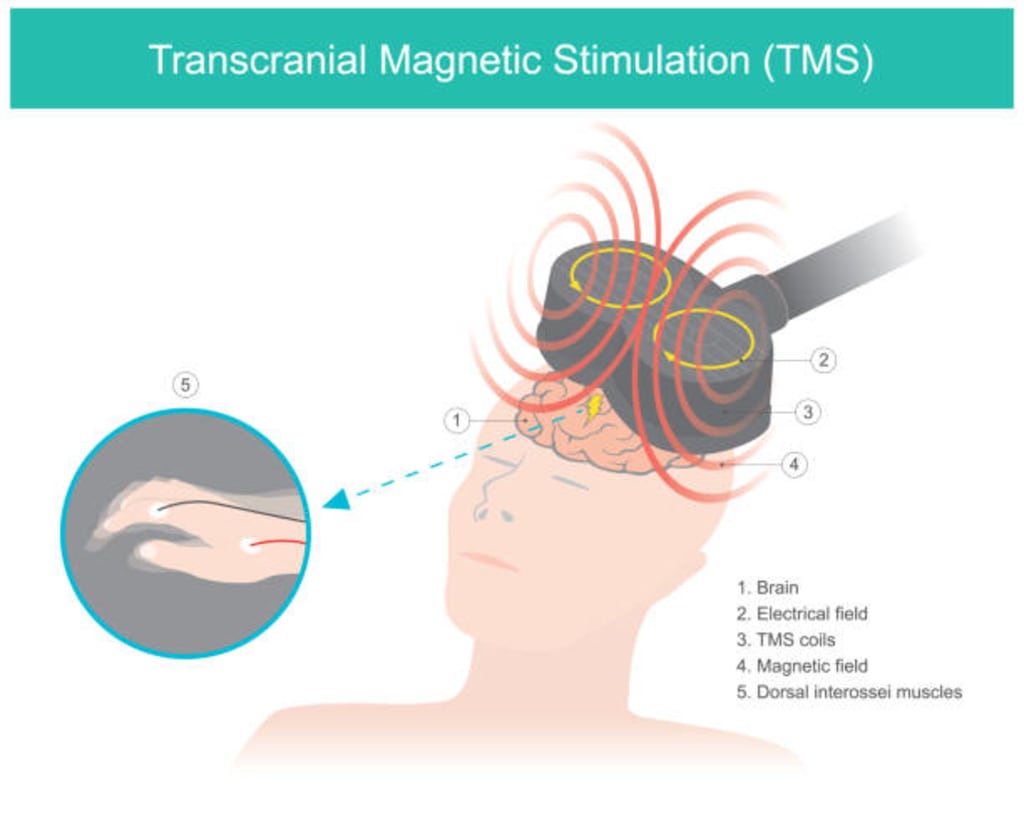Transforming Lives with TMS Therapy
A Revolutionary Approach to Mental Health Treatment

Transcranial Magnetic Stimulation (TMS) therapy is an innovative non-invasive procedure that has gained recognition as a breakthrough treatment for various mental health conditions. This article delves into TMS therapy's principles, benefits, and potential applications, offering insights into its transformative potential.
Understanding TMS Therapy
TMS therapy is based on the understanding that certain mental health conditions, such as depression, involve an imbalance or dysfunction in specific brain circuits. TMS therapy modulates neural activity and restores normal functioning by targeting and stimulating these circuits using magnetic fields.
The prefrontal cortex, a brain region involved in mood regulation and emotional processing, is a common target for TMS therapy. Research suggests that individuals with depression may have reduced activity in this area. TMS therapy delivers magnetic pulses to the prefrontal cortex, which stimulates neural activity and promotes the release of neurotransmitters associated with mood regulation, such as serotonin, norepinephrine, and dopamine. By increasing neural activity in this region, TMS therapy aims to rebalance the disrupted circuitry and alleviate symptoms of depression and other related conditions.
The underlying logic of TMS therapy is that directly influencing neural activity in targeted brain regions can induce neuroplastic changes that can restore proper functioning and alleviate symptoms of mental health disorders. The repetitive nature of the magnetic pulses promotes the reorganization and strengthening of neural connections, leading to longer-lasting therapeutic effects. This approach offers an alternative to traditional treatments like medication, providing a more targeted and localized intervention for individuals who have not adequately responded to other forms of therapy.
Conditions Treated by TMS
TMS therapy is primarily used to treat various mental health conditions, particularly those that have not responded adequately to traditional treatments like medication or therapy. One of the most common conditions treated with TMS therapy is major depressive disorder (MDD), specifically treatment-resistant depression. Studies have shown that TMS therapy can significantly reduce depressive symptoms and improve overall well-being in individuals who have not experienced sufficient relief from antidepressant medications. TMS therapy has also shown promise in treating other mood disorders, such as bipolar depression.
In addition to depression, TMS therapy has been explored as a treatment option for other psychiatric conditions. It has shown efficacy in treating anxiety disorders, including generalized anxiety disorder (GAD) and obsessive-compulsive disorder (OCD). TMS therapy has also been investigated for managing conditions like post-traumatic stress disorder (PTSD), schizophrenia, and chronic pain. While further research is ongoing to establish the full range of conditions that can benefit from TMS therapy, its potential extends beyond depression to offer new options for individuals with various mental health disorders.
How TMS Works
TMS therapy uses electromagnetic coils to generate magnetic fields that penetrate the scalp and skull to reach specific brain areas. These magnetic fields induce electrical currents in the targeted brain regions, modulating neural activity. TMS therapy typically focuses on the prefrontal cortex, a part associated with mood regulation.
During a TMS session, a coil is placed on the scalp, and repetitive magnetic pulses are delivered to the targeted brain area. Depending on the parameters, these pulses create small electrical currents that activate or inhibit neurons. The stimulation is typically painless, although some individuals may experience mild discomfort or tingling sensations on the scalp.
Throughout multiple TMS sessions, the repeated magnetic stimulation prompts neuroplasticity - the brain's ability to reorganize and form new connections. This neuroplasticity can help rebalance abnormal neural activity associated with mental health conditions. By modulating brain circuits involved in mood regulation, TMS therapy aims to alleviate symptoms of depression, anxiety, and other psychiatric disorders. The specific treatment protocol, including the number of sessions and frequency, may vary depending on the individual and the nature of their condition.
Safety and Non-Invasiveness
TMS therapy is considered a safe and non-invasive treatment option for mental health conditions. It does not involve any surgical procedures or the use of anesthesia. The magnetic pulses used in TMS therapy are delivered through a coil placed on the scalp, penetrating the skull to reach the targeted brain areas. The procedure is generally well-tolerated by most individuals.
The non-invasive nature of TMS therapy means that it does not require any surgical incisions or implants. This significantly reduces the associated risks and complications compared to invasive procedures. TMS therapy sessions are typically outpatient, allowing individuals to return to their daily activities immediately after the treatment without any significant downtime or recovery period. The procedure can be performed in a clinical setting without hospitalization.
Regarding safety, TMS therapy has been extensively studied and has a favorable safety profile. Common side effects of TMS therapy are generally mild and transient, such as scalp discomfort, headache, or tingling sensations. Severe adverse effects are rare, but precautions are taken to ensure the safety of individuals undergoing TMS therapy, including screening for contraindications and closely monitoring treatment parameters. Overall, TMS therapy's non-invasive nature and favorable safety profile make it a viable treatment option for individuals seeking alternatives to medication or other invasive procedures.
The Treatment Experience
The treatment experience of TMS therapy typically involves a series of sessions over several weeks. Each session lasts 20 to 30 minutes, and multiple sessions are necessary to achieve the desired therapeutic effects. The treatment plan may vary depending on the individual's condition and response to the therapy.
During a TMS session, the individual sits in a comfortable chair, and a technician places a magnetic coil on the scalp in the targeted area of the brain. The coil emits magnetic pulses, which create clicking sounds and a tapping sensation on the scalp. While some individuals may experience mild discomfort or tingling during treatment, TMS therapy is generally well-tolerated, and anesthesia or sedation is not required.
Throughout treatment, individuals can typically engage in activities such as reading, listening to music, or watching television. After each session, they can resume their daily routines without significant restrictions. The number of sessions required for optimal results varies. Still, it is common for individuals to undergo TMS therapy for several weeks, receiving treatment on weekdays. The treatment experience of TMS therapy is generally considered convenient and manageable for individuals seeking a non-invasive alternative for their mental health conditions.
Personalized Approach and Efficacy
TMS therapy adopts a personalized approach to treatment, considering each individual's specific needs and characteristics. Before starting TMS therapy, a thorough evaluation is conducted to assess the individual's condition, medical history, and treatment goals. This evaluation helps determine the optimal target area in the brain for stimulation and the appropriate treatment parameters, such as the intensity and frequency of the magnetic pulses. TMS therapy aims to maximize its effectiveness and increase the chances of achieving positive outcomes by tailoring the treatment plan to the individual.
Extensive research and clinical studies have supported the efficacy of TMS therapy. It has shown promising results, particularly for individuals with treatment-resistant depression who have not responded adequately to other forms of treatment. Studies have indicated that TMS therapy can significantly reduce depressive symptoms and improve overall well-being in a substantial proportion of individuals. Furthermore, TMS therapy has effectively treated anxiety disorders, bipolar depression, and chronic pain. While individual responses to TMS therapy may vary, it has proven a viable treatment option for many individuals seeking relief from mental health conditions. Ongoing research continues to explore the potential of TMS therapy and refine its application to optimize its efficacy across different populations and situations.
TMS in Combination with Other Treatments
TMS therapy can be combined with other treatments to enhance its effectiveness or as part of a comprehensive treatment plan for certain mental health conditions. When used in conjunction with medication, TMS therapy can augment the therapeutic outcomes, particularly for individuals who have had a partial response to antidepressant medications alone. This combination approach, augmentation therapy, aims to provide a more comprehensive and targeted intervention. The specific medication regimen and TMS treatment parameters are determined based on the individual's needs and their healthcare provider's recommendation.
TMS therapy can also be integrated into psychotherapy or counseling as a multimodal treatment approach. Combining TMS therapy with psychotherapy, such as cognitive-behavioral therapy (CBT), can be beneficial in addressing the psychological and behavioral aspects of mental health conditions. The neurostimulation provided by TMS therapy can enhance the brain's receptivity to treatment and promote deeper therapeutic insights and changes. This integration allows for a holistic treatment approach that targets biological and psychological factors contributing to the individual's condition.
It is important to note that the specific combination of treatments will depend on the individual's unique needs and their healthcare provider's recommendations. Integrating TMS therapy with other treatments aims to optimize outcomes and provide a comprehensive approach to managing mental health conditions. Close collaboration between the healthcare team members is crucial to ensure the safety and effectiveness of the combined treatment approach.
TMS therapy represents a groundbreaking advancement in mental health treatment, offering hope to individuals struggling with depression. With its proven efficacy, minimal side effects, and non-invasive nature, TMS therapy is reshaping the mental healthcare landscape, providing new avenues for transformation and improved well-being.
About the Creator
Antonio Privitera
A resilient soul, overcoming mental health struggles while inspiring others, destigmatizing mental health, and advocating for a brighter future.






Comments
There are no comments for this story
Be the first to respond and start the conversation.